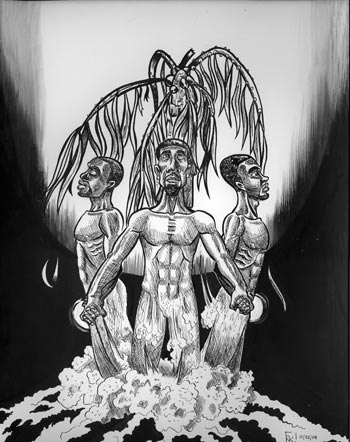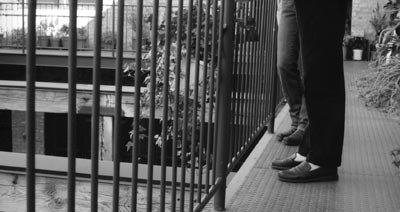By Madeline Nusser
To get to an exhibition on the fourth floor means experiencing the entirety of the Museum of Surgical Science at a glance while climbing the historic lakeside mansion’s marble staircase. In doing so, one must pass cases of antique medical equipment and view displays of ancient and mid-century human deformities before reaching Jason Lazarus’s solo show Congenital: Grafts (open through January 21).
The exhibition is part of Anatomy in the Gallery, the Museum of Surgical Science’s series of rotating exhibits created in 1998 to “Introduce a contemporary art element into the historic museum.” While putting new art into a sanctuary for surgical history may seem like a wacky idea, the museum dedicates much of its space to surgical science’s effect on art, displaying doctors’ drawings as well as murals of historical medical events such as “First Ovariectomy.” The great amount of medical art in the Museum’s permanent collection is evidence that art and science have always been inexorably intertwined.
Lazarus’s work adds to the dialogue of art and medicine by bringing an artist’s view of surgical science to the foreground. The works in Congenital: Graphs are photographic self-portraits, which examine the artist’s body and irregularities brought about by a congenital disease and years of accompanying, often scarring, surgery. The photographs are tied together through a compositional similarity„body parts on a black background„that somewhat mimic the style of scientific photographs. Although this genre is known to lack humanism, the large scale of Lazarus’s photographs and the subtle narratives they invoke reveal the deeply personal role that surgery has played in Lazarus’s life.
The large color photographs occupy a small gallery at the top of the museum. The work that begins the exhibition is an image of the artist from waist to forehead lying vertically, hand clenched over mouth, his eyes staring at the viewer. Although at first glance the image could invariably be any young male specimen, a closer look reveals a body out of proportion. The wrist and arms are thinner than the joints that connect them. Noticing the artist’s bodily deformity reinterprets the first photograph in theexhibition. The hand gripped tightly over the mouth and the confronting eyes suggest the artist’s immutable awareness of the viewer’s perceptions.
The photographs are made through a process where Lazarus scans himself on a digital scanner. This act is comparable to the artist’s lifelong process of being x-rayed, a procedure that is meant to help cure his physical birth defects. The scanning process is rendered into a similar antidote for emotional defects by doing what the artist refers to as ”addressing the visual difference of the affliction.” After several smaller scans are taken, they are digitally stitched together and altered into seamless images which reveal many of the physical defects as well as their emotional remains.
One striking photograph is of the artist’s feet enlarged to almost abstract proportions. Scaly skin presses against the photograph’s surface while the plains of the body ebb into the black background. The legs, thinner than the ankle joints, have slight indentations, presumably scars from surgical operations. In the context of the museum it is immediately recognizable that the body has been morphed by surgery. But in the photographs, the scars are also faintly drawn lines that are beautiful in their grotesqueness, their ability to acutely well up feelings of pain in the viewer.
The humanization of the artist’s body is in conflict with the Museum’s distant treatment of the body as specimen. This sets up a fine line of distinction between being put on display as a visual sample and asserting artistic authority as an individual. Lazarus photographically controls views of himself, resulting in his body not being an object of the viewer’s gaze. Yet one senses the photographs tugging at the artist’s feelings of isolation from his own body.
Related Links: [email protected]
December 2004







